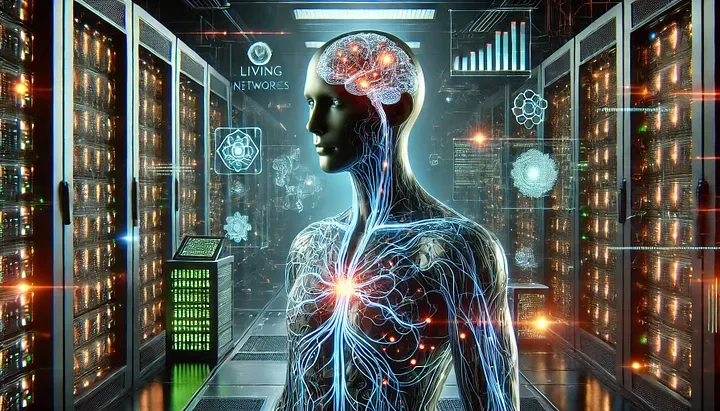Living Intelligence

This week’s post is also available as a podcast if you prefer to listen on the go or enjoy an audio format:
Living Intelligence and Artificial Intelligence mark a new chapter in human understanding and possibly human evolution.
As artificial intelligence continues to advance, it increasingly mirrors characteristics we once thought unique to living beings. This evolution, nothing short of awe-inspiring, makes us reconsider our definitions of life, consciousness, and autonomy. The growing similarities between AI systems and biological entities raise new questions about intelligence while raising essential societal impact and ethical governance considerations.
Modern AI systems display several key characteristics that parallel biological life forms. These systems can now operate with increasing independence, making decisions and completing complex tasks with minimal human input. They adapt to changing conditions through sophisticated machine learning and neural networks and refine their processes based on new information and experiences. While AI consciousness remains debatable (Indeed, we are not even sure we understand what consciousness is.), current developments hint at the possibility of systems that can recognize their existence and purpose. Perhaps most striking is their ability to generate original content — from artwork to music to novel solutions for complex problems.
The foundation of these advancing capabilities rests on several key technological developments. Machine learning algorithms allow systems to identify patterns and make predictions from large amounts of data, creating the building blocks for adaptable behavior. Neural networks, taking inspiration from biological brains, process information through multiple connected layers to enable sophisticated problem-solving. Through reinforcement learning, AI systems discover optimal behaviors by experimenting with their environment, like how animals learn. Physical embodiment through robotics adds another dimension, allowing AI to interact directly with the world around it.
The development of increasingly sophisticated AI forces us to grapple with fundamental questions about the nature of existence. We must consider whether systems displaying life-like traits deserve consideration as a form of life themselves and how to distinguish meaningfully between artificial and natural intelligence. This leads to practical questions about potential rights for AI systems and our ethical obligations toward them. At the same time, we face the essential challenge of maintaining meaningful human control while allowing these systems to develop their capabilities. These ethical considerations are theoretical and have real-world implications for the future of AI and our society.
The advancement of AI opens new possibilities across many fields, offering a beacon of hope in addressing complex global challenges. These systems could help address complex global challenges, from environmental protection to breakthroughs in medical research to improved disaster response. Working alongside humans, advanced AI could enhance our problem-solving abilities and creative potential. Their ability to operate in challenging conditions could also lead to new approaches in space exploration, deep-sea research, and other extreme environments.
However, this progress raises essential concerns. As AI systems become more autonomous, their actions may become more challenging to predict or control. AI goals might not align perfectly with human interests, potentially leading to unexpected outcomes. We must also consider how increasing reliance on intelligent systems might affect human capabilities and independence over time.
Popular culture often explores possible futures involving advanced AI, ranging from optimistic visions of cooperation to darker conflict scenarios. While these imaginative explorations can seem extreme, they underscore the importance of careful planning and ethical consideration as we develop these technologies. It’s a responsibility we must all take seriously.
The development of increasingly sophisticated AI represents an extraordinary opportunity and a significant challenge to our understanding of intelligence and life. Considering the benefits and risks, we can work toward a future where advanced AI enhances human capability while maintaining appropriate safeguards. Our decisions today about developing and implementing these technologies will shape the relationship between human and artificial intelligence for generations to come.
Thank you for being a part of this fascinating journey.
BearNetAI. From Bytes to Insights. AI Simplified.
BearNetAI is a proud member of the Association for the Advancement of Artificial Intelligence (AAAI), and a signatory to the Asilomar AI Principles, committed to the responsible and ethical development of artificial intelligence.
Categories: Artificial Intelligence, Ethics, Machine Learning, Future Technologies, Robotics
The following sources are cited as references used in research for this post:
Bostrom, N. (2014). Superintelligence: Paths, Dangers, Strategies. Oxford University Press.
Brynjolfsson, E., & McAfee, A. (2014). The Second Machine Age: Work, Progress, and Prosperity in a Time of Brilliant Technologies. W. W. Norton & Company.
Goodfellow, I., Bengio, Y., & Courville, A. (2016). Deep Learning. MIT Press.
Kurzweil, R. (2005). The Singularity Is Near: When Humans Transcend Biology. Viking.
Russell, S., & Norvig, P. (2020). Artificial Intelligence: A Modern Approach. Pearson.
Tegmark, M. (2017). Life 3.0: Being Human in the Age of Artificial Intelligence. Knopf.
Vinge, V. (1993). The Coming Technological Singularity: How to Survive in the Post-Human Era. Vision-21 Symposium Proceedings.
Wiener, N. (1948). Cybernetics: Or Control and Communication in the Animal and the Machine. MIT Press.
Glossary of terms used in this post:
Algorithm: A set of rules or steps designed to solve a specific problem or perform a computation.
Autonomy: The capability of a system to operate independently without human intervention.
Embodied AI: Artificial intelligence integrated into physical systems, such as robots, enabling interaction with the physical world.
Machine Learning (ML): A subset of AI that enables systems to learn and improve from experience without being explicitly programmed.
Neural Networks: Computational models inspired by the human brain’s structure, used to process complex data inputs.
Reinforcement Learning: A type of machine learning where agents learn by interacting with an environment and receiving rewards or penalties.
Self-Awareness: The ability of a system to recognize its existence and reflect on its actions and purpose.
Sentience: The capacity to feel, perceive, or experience subjectively.
Singularity: A hypothetical future point where AI surpasses human intelligence, leading to unprecedented technological growth.
Turing Test: A test of a machine’s ability to exhibit intelligent behavior indistinguishable from that of a human.
BearNetAI, LLC | © 2024, 2025 All Rights Reserved